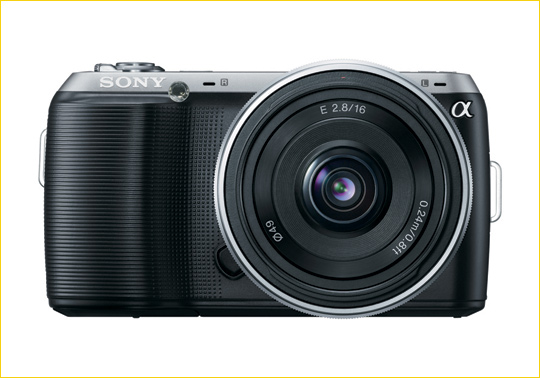
June 8, 2011
Sony has today announced two new cameras, the A35 and NEX-C3. Both cameras share the same new 16.2 Megapixel sensor. I have been working with the C3 for the past few weeks and you will find here some initial impressions. The C3 will ship together with the 18-55mm f/3.5-5.6 kit lens in late July for $749 .
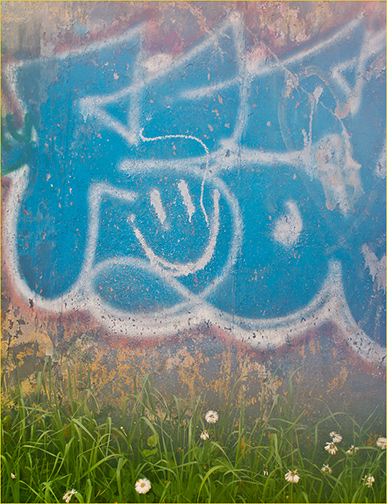
Fog Graffiti. Caledon, Ontario. May, 2011
Sony NEX C3 with 18-55mm @ ISO 200
Camera Size and Lenses
The C3 is the smallest NEX camera body yet, and NEX cameras are the smallest interchangeable lens cameras available – even smaller than Micro Four Thirds. This is the case even though the NEX sensor is full APS-C sized, the same as in mainstream DSLRs.
But though the body size of NEX cameras is positively tiny (as small as some pocket digicams), the lenses are constrained by the laws of optics because they must cover such a large sensor. In other words, though Sony has done their best to slim down NEX lens barrels, and uses very elegant-looking stainless steel construction, these are still largeish lenses, especially when compared to Micro Four Thirds.
Wherein lies Sony’s quandary. Clearly a mirrorless large sensor camera can be made every small indeed. But lenses, not so much. The only so-called pancake lens in Sony’s current and even forthcoming lens line up is the 16mm f/2.8. Even the kit 18-55mm is largish on the diminutive C3 and still quite slow.
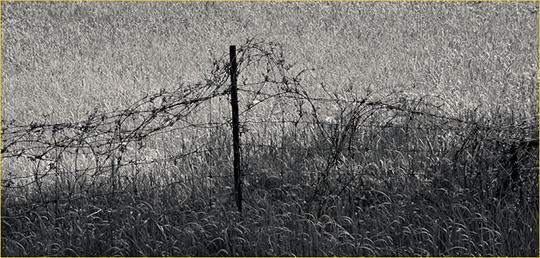
Barbs and Grass. Caledon, Ontario. May, 2011
Sony NEX C3 with 18-55mm @ ISO 200
To make the C3 even smaller Sony has made a few design changes, not all of which I think are for the good. The SD card slot no longer shares the battery compartment, having its own bottom panel door. This is fine as far as it goes, but it does mean that if the camera is on a tripod or a mount accessory is attached, it will have to be removed.
Of greater significance; the grip area found on the NEX-5 has been removed to make the camera slimmer and the shutter release moved to the top panel rather the front edge of the grip. This dramatically changes the handling of the camera.
I have mid-sized hands, and find that NEX-5 just manageable. The C3 much less so. This is because ones forefinger is now tilted back to reach the shutter button, rather than remaining comfortably foreword. And with the kit lens attached, let alone anything larger and heavier, ones grip is compromised and the camera sags to the left because of the lens’ weight.
The more cramped grip of the C3 as compared to the NEX-5 means that one is forced to hold the camera more tightly, and I constantly found myself accidentally pressing the bottom soft key with my palm, something that never happened with the NEX-5. Plainly put, I feel that in its pursuit of making NEX cameras smaller, with the C3 Sony have gone too far and compromised hand-holdability.
The Lens / Size / Aperture Quandary
OK – here’s the deal. The NEX bodies are very small. But as already mentioned the lenses are still APS-C sized. To keep them within reason in terms of size they have modest maximum apertures. Even the pancake 16mm is just an f/2.8. Now, compare this to a pocket-sized camera like theOlympus XZ-1(review coming soon). This has a 28–112mm (equivalent) lens with an aperture of f/1.8 – f/2.5.
Of course the C3 has a 16MP sensor and the XZ-1 has a 10MP sensor, and the NEX’s sensor is also significant larger, which means better image quality. Right? Well, yes, but….
Thebutis that when working in anything but bright outdoor conditions one is going to have to shoot the C3 at a higher ISO, because the lens is slower. A full two to three stops slower. So indoors, instead of ISO 400, for example, the C3 would have to shot at ISO1600 to ISO 3200, thus cutting its larger sensor advantage considerably. Combine this with the XZ-1’s smaller size, superior user interface, and lower price, and theraison d’etrefor the C3 starts to erode. The Panasonic LX5 and Samsung EX-1, two other pocket cameras with moderate sized sensors and fast zoom lenses are similarly equipped.
In my view the NEX series desperatly needs faster lenses. But, to keep size down they should be primes.
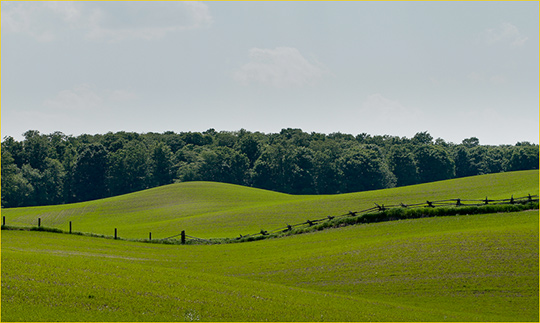
Rolling Grass. Caledon, Ontario. May, 2011
Sony NEX C3 with 18-200mm @ ISO 200
The User Interface
I expressed dissatisfaction with the original NEX user interface, as did virtually every other reviewer. Sony was pretty quick to try and address these complaints with a firmware update, but in my view it still didn’t solve the main problem, and that’s one of overall usability.
The concept behind the NEX cameras was to produce a camera that provided advanced user features, but aimed at the point-and-shoot user moving up. To accomplish this the number of external controls was reduced to a bare minimum, and various control selections made accessible behind pretty icon-based menus.
Regrettably, that had the effect of placing various selections and controls in six different icon accessed sections, each separated from the other by one having to navigate through a central menu screen. Every time a change is made to a function the user is dropped back to the central menu. Want to experiment, and try things a couple of different ways? Back through the main menu each time. Annoying and frustrating!
Unless and until one memorizes where a certain setting is to be found, it’s a matter of hunting. Other cameras (including those from Sony) have menu sections branching from a common interface, making finding what one is looking for much more intuitive.
Overall I find the NEX interface to be the least friendly and most unintuitive of any current camera. It neither aids the beginner not comforts the more advanced user.
Peaking
One of the most interesting new features on the C3 is the addition of “Peaking” when a manual focus lens on an adaptor is mounted. The peaking controls are found on the Setup menu, and include the choice of edge colour (Red, White and Yellow), and level of sensitivity, (Off / Low / Medium and High). Peaking, if you’re unfamiliar with it from the video world, shows a shimmering outline on the parts of the image that are in sharpest focus.
Also, as an aid to focusing with non-AF lenses, when a lens adaptor is attached the bottom soft key automatically changes toMF Assist, and screen magnifications to assist focusing of 7.5X and 15X are available. This combined withPeakingprovides the best focus assist capability that I’ve yet seen on a new generation camera.
Firmware
There’s good news. The new firmware found on the C3 will be available as an update for current NEX-3 and NEX-5 owners, so if you are keen to havePeakingthis will be available for your previous NEX camera around the same time that the NEX C-3 is announced. Now Available Here.
Other Features
As with the NEX-3 and NEX-5 Sony incorporates a wide range of features, some worthwhile and some gimmicks. Sony’s excellent Sweep Panorama mode is still here, and continues to be the best implementation of simplified pano shooting around.
I won’t innumerate most of the other modes, such as Hand-Held Twilight, Anti-Motion Blur, D-Range Optimizer and Auto-HDR. These have all been seen before. But one that’s new with the C3 is a mode accessible from the main Mode menu calledPicture Effects.
Picture Effects
This mode allows users who aren’t interested in working on the images with a computer to create a number of interesting effects, including ones named Retro, Pop, Posterized B&W, Posterized Color, Toy, Hi Contrast B&W, Hi Key, and Partial Red, Blue, Green and Yellow.
These later effects are well done, with just objects in those colours being displayed in colour, and the rest of the image in B&W.
The ClearViewer
I’ve made no secret of the fact that I really dislike working with cameras without eye-level viewfinders. Optical, reflex, electronic –I don’t that much care– as long as there’s something that I can use so as to shoot with the camera up to my eye, rather than at arm’s length with an LCD screen.
When theNEX-5was introduced I expressed my disappointment that an EVF was not available, but expected that one would be forthcoming. But a year later Sony has failed to satisfy this hope. The lack of an accessory EVF is to my mind a serious handycap for the NEX line thus far. I don’t know if, as is the case with Panasonic and Olympus cameras, the accessory port is capable of supporting an EVF, but if it isn’t I really hope that Sony addresses this shortcoming soon.
Here are my current alternatives for eye level viewing.
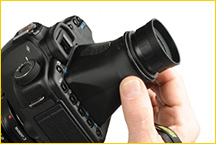
TheHoodman Hoodloupe can theoretically do the job, but its much too large for use with a camera as small as a NEX C3, and it requires annoying rubber straps to attach. But there is a solution. It’s small, relatively inexpensive, and works well enough that it should be provided by Sony with every NEX camera sold (at least until they get around to providing an accessory EVF).
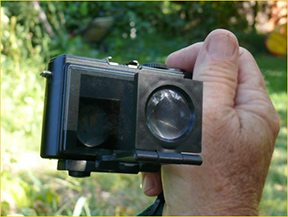
TheClearviewer is the best solution that I have found. It looks a bitRube Goldbergishbut it works surprisingly well, and folds out of the way when not needed. The only time that it fails is outdoors when the sun is at 90 degrees and washes out the screen. But moving ones hand a bit to block the sun works fine. TheClearVieweris a simple yet brilliant solution. Highly recommended.
Be aware though that because the C3’s SD card slot has been moved from its spot inside the battery compartment to a separate one close to the tripod socket, unlike on the NEX-3 and NEX-5 the Clearviewer needs to be removed to charge cards.
Image Quality
I know that this will annoy a lot of people, but I’m going to take a pass on shooting high ISO noise and other test images for the article. The truth of the matter is that this sensor is Sony’s latest; the same one found in their new A35, as well as the Pentax K5, Nikon D7000 and Sony A580, all highly regarded when it comes to image quality.
The real difference between cameras of similar similar price and feature set lies in their usability. This isn’t something that beginners care to hear, but it’s what many advanced photographers eventually end up regarding as being of greatest importance – assuming that basic IQ is there. If the camera is difficult to use it really doesn’t matter that it scores 2 points higher than another on DxO Mark. It’s simply not going to get the shot, or if it does it won’t be all that enjoyable to use.
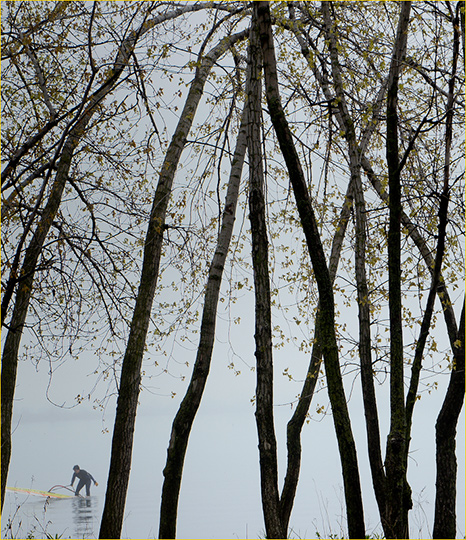
Surfing the Trees. Toronto. May, 2011
Sony NEX C3 with 18-55mm @ ISO 200
The Bottom Line
And therein lies the NEX C3’s problem. Indeed the entire NEX line so far. It is atour de force of hardware design. Greats sensors, small physical size, very good quality and beautifully made lenses (with a limited range at the moment), but a user interface that neither meets the needs of the beginning user stepping up from a point-and-shoot, nor the more advanced user looking for something small but with high quality. A camera that they can carry when their DSLR is too bulky.
This camera is loaded to the hilt with gizmos and gadgets. More features, bells and whistles than most people will ever be able to get their heads around. But who is it for? I’ve spent time with both beginners and advanced photographers showing them and discussing previous NEX cameras, trying to understand how different people perceive this class of camera. My experience is that beginners almost immediately ask if there isn’t something simpler available, and more advanced users just get frustrated by trying to access controls via the camera’s unintuitive interface.
It’s been interesting to note that in Japan Sony NEX cameras are selling very well, and claiming some significant market share. I can understand that, because there is a mainstream cultural bias in Japan favouring complex technology and features. The more so the better. But my sense is that this is not the case among consumers in general, at least in North America.
I’ve been reading recently that there is strong consumer push-back in the US against 3D movies and TVs, even though all the major studios and TV makers are flogging 3D relentlessly. I see a parallel between 3D and all the gizmology built into some recent cameras. Why is it there? Because it’s just firmware, and firmware is less expensive to implement in the feature wars than hardware.
In the end the Sony NEX-C3 brings to the line a terrific new sensor and an even smaller though more difficult to hold body.Peakingis a very worthwhile addition for anyone using manual focus lenses via an adaptor, but since this feature will be available to NEX-3 and NEX-5 users via a firmware upgrade it isn’t a purchase motivator for current owners.
If having the world’s smallest interchangeable lens camera with a top ranked APS-C sensor is something that attracts you, then the new Sony NEX C-3 is the ticket. For entry level photographers looking for top image quality combined with lots of features and gizmos there likely isn’t a better choice, though time will have to be spent becoming familiar with the unconventional interface. For the more experienced photographer looking for a high quality portable camera I might suggest waiting for the NEX-7, which is rumoured to not be far off. Hopefully it will have an available EVF and more amenable user interface.
June, 2011
